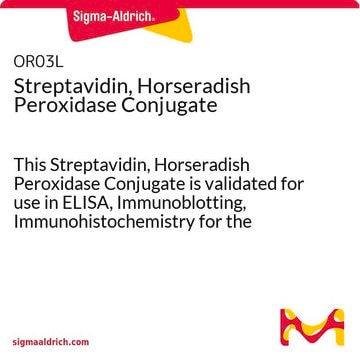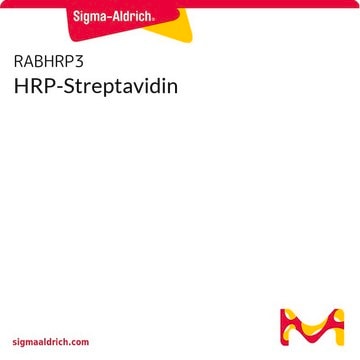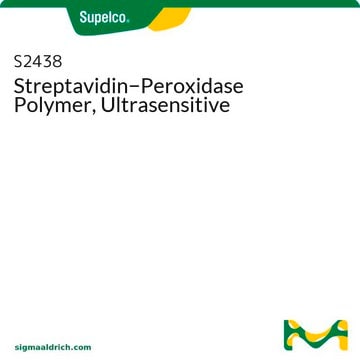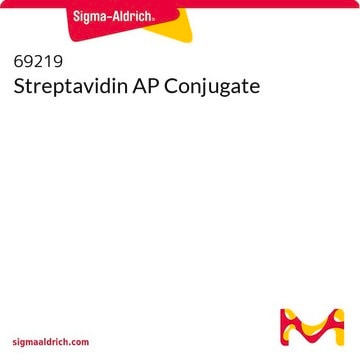11089153001
Roche
Streptavidin-POD conjugate
liquid, pkg of 1 mL
Synonym(s):
streptavidin
Sign Into View Organizational & Contract Pricing
All Photos(1)
About This Item
UNSPSC Code:
12352200
Recommended Products
General description
Streptavidin is covalently coupled to horseradish peroxidase. The conjugate is used for detection of biotin-labelled substances.
Application
Streptavidin-POD has been used for:
- ELISA
- In situ hybridization
- Western blot
Unit Definition
One unit Streptavidin-POD, corresponding to one unit peroxidase, will oxidize 1 μmol of guaiacol tetramer in one minute at +25 °C and pH 7.0.
Unit Conversion: 1 U (+25 °C; guaiacol as substrate; pH7.0) corresponds to 1.24 U (+25 °C; 1.7 mM ABTS as substrate; pH= 6.0) or to 4.0 U (+25 °C; 8.7 mM ABTS as substrate; pH = 5.0).
Unit Conversion: 1 U (+25 °C; guaiacol as substrate; pH7.0) corresponds to 1.24 U (+25 °C; 1.7 mM ABTS as substrate; pH= 6.0) or to 4.0 U (+25 °C; 8.7 mM ABTS as substrate; pH = 5.0).
Physical form
Liquid, stabilized
Preparation Note
Working concentration: 5 - 500 mU/ml (i.e., stock solution can be diluted).Working concentration of conjugate depends on application and substrate. The following concentrations should be taken as a guideline:
- ELISA: 50 to 200 mU/ml
- Immunohistocytochemistry: 250 to 1000 mU/ml
- Western blot: 200 to 500 mU/ml
Other Notes
For life science research only. Not for use in diagnostic procedures.
Signal Word
Warning
Hazard Statements
Precautionary Statements
Hazard Classifications
Skin Sens. 1
Storage Class Code
11 - Combustible Solids
WGK
WGK 1
Flash Point(F)
does not flash
Flash Point(C)
does not flash
Certificates of Analysis (COA)
Search for Certificates of Analysis (COA) by entering the products Lot/Batch Number. Lot and Batch Numbers can be found on a product’s label following the words ‘Lot’ or ‘Batch’.
Already Own This Product?
Find documentation for the products that you have recently purchased in the Document Library.
Customers Also Viewed
Rebeca M Torrente-Rodríguez et al.
Matter, 3(6), 1981-1998 (2020-10-13)
The COVID-19 pandemic is an ongoing global challenge for public health systems. Ultrasensitive and early identification of infection is critical in preventing widespread COVID-19 infection by presymptomatic and asymptomatic individuals, especially in the community and in-home settings. We demonstrate a
Husheem Michael et al.
Frontiers in immunology, 11, 196-196 (2020-03-03)
Human rotavirus (HRV) is a leading cause of morbidity and mortality in children, especially in developing countries. Malnutrition is prevalent in these countries, which may contribute to the decreased oral vaccine efficacy, posing a concern for global health. Neonatal gnotobiotic
Sebastian Heber et al.
Frontiers in pharmacology, 12, 809595-809595 (2022-01-22)
Clostridioides (C.) difficile produces the exotoxins TcdA and TcdB, which are the predominant virulence factors causing C. difficile associated disease (CDAD). TcdA and TcdB bind to target cells and are internalized via receptor-mediated endocytosis. Translocation of the toxins' enzyme subunits
Christian Reichel et al.
Drug testing and analysis, 15(2), 163-172 (2021-01-16)
Erythropoietin (EPO) is a hormone, which stimulates the production of red blood cells. Due to its performance-enhancing effect, it is prohibited by the World Anti-Doping Agency (WADA). In order to reduce the detection window of EPO doping, athletes have been
Angelika Hammerer-Lercher et al.
Clinical chemistry, 54(5), 858-865 (2008-03-15)
The specific forms of pro-B-type natriuretic peptide (proBNP) that occur in human blood are not yet clear. We demonstrated the presence of several proBNP forms in human plasma with a new affinity chromatography method that can be used in combination
Our team of scientists has experience in all areas of research including Life Science, Material Science, Chemical Synthesis, Chromatography, Analytical and many others.
Contact Technical Service














